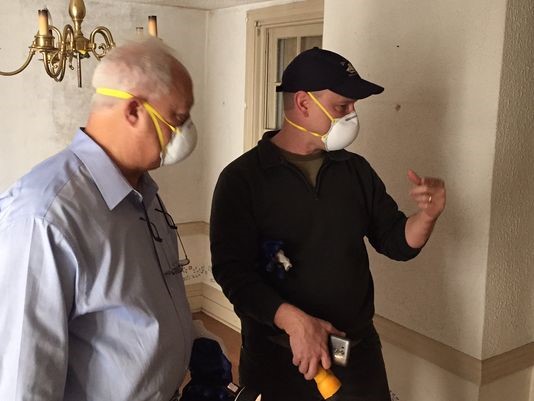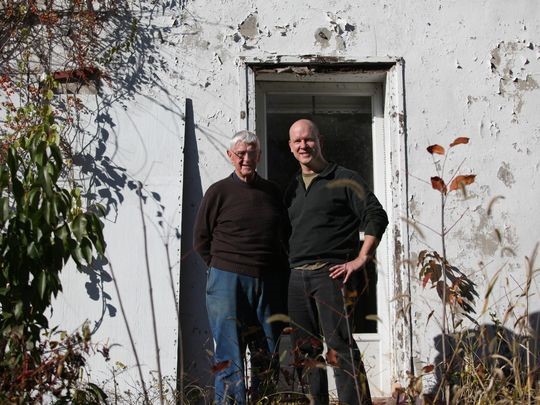Contact - Volunteer - Contribute - (302) 468-6024

|
||||||||||||||||||||||||||
| Bob Weiner News | ||||||||||||||||||||||||||
|
12/7/2015 New Castle County seeks solution for historical homes
Alan Baseden (right), with Jester Artspace, talks with New Castle County Councilman Bob Weiner about renovations at the Jester Farmhouse in Brandywine Hundred on Nov. 16. A plan calls for the organization to occupy the structure, which has been empty for years.(Photo: DAMIAN GILETTO/THE NEWS JOURNAL) Story Highlights • New Castle County is considering allowing a nonprofit arts startup to occupy the Jester Farmhouse. A new option may be on the horizon for how New Castle County can preserve its stock of aging – and in some cases, crumbling – historical buildings situated in parkland areas. Officials are considering allowing a nonprofit arts startup to occupy the Jester Farmhouse, a long-vacant pre-Civil War home on county-owned land in Brandywine Hundred. Under the proposal, the group – which will be named Jester Artspace – will rent the property for free, with the condition that substantial improvements to the historical building are made. The move seeks to address a common problem when governments make large park purchases: Along with all that land, there often are historical buildings that need lots of upkeep. Plans to demolish such buildings are often met with opposition from neighbors. Jim Hall, chief of cultural resources for Delaware State Parks, which oversees historical residences on state-owned land, said having a nonprofit step in is something of a new model – the building is saved and is put to good use. "I think it seems to be a winning trend. In the economic climate we are in right now, it is much easier for a nonprofit to be able to pull together resources,” he said. New Castle County has 11 historical properties. Some are not on the National Register of Historic Places, but are significant to neighbors as a reminder of the area's past. All came into county hands through land acquisitions. Homes range from the Hermitage, a 23-acre farm in Glasgow Park, to Talley-Day House, an 1847 farmhouse in Brandywine Hundred’s Talley Day Park. The county took over the Jester property, in the 2800 block of Grubb Road, when the 26-acre parcel on which it sits was purchased in the 1970s for open space. The building has sat empty for decades, falling into disrepair. The two-story home today has a pock-marked and fading white façade, rusty tin roof and boarded-up windows. Currently, the county doesn't make substantial renovations to the older structures on county parkland. Rather, only emergency repairs are made, and there is no annual budget. An exception is Rockwood, a 1854 home on Shipley Road that the county received in 1973 and now houses a museum. Several other historical homes statewide – including the Parson Thorne Mansion in Milford and John Dickinson House in Dover – house similar museums. 'It can be a tough sell' The nonprofit development is a twist on the county’s existing Resident Curator Program, created about a decade ago to have qualified renters move in to historical structures, live for free and promise to invest in repairs. Curators work with the county to create a maintenance and renovation plan to protect historical aspects. The program was seen as a win-win – a building would be preserved, and no taxpayer dollars would be used. "The county's part was, ‘Let’s not get these houses in such disrepair that we have to raze them because we didn't do anything about it,’ " said Robert Merrill, who manages the curatorship program for the county. But the initiative struggled to attract widespread interest, and today only three of the 11 New Castle County historical properties on parkland have curators. Some are too damaged to be saved. Some of the problem was the sheer cost of improvements – at least $150,000 had to be spent over five years – and amount of work needed, without the resident ever owning the building. Upon the curator's death, the structure reverts back to government control. "It can be a tough sell," Merrill said. "A lot of people want to do it, but when they see that nothing is passed along to their heirs, you really have to love historic homes to get involved in this." One county property, the Woodstock Mansion in Banning Park, currently has resident curators. Two others are occupied by government employees as curators while others are damaged to the point that they are likely to be demolished. "You have to suck it up," said Jane Katsnelson, who has invested hundreds of hours working on Woodstock Mansion since she and her husband became curators three years ago. Jon Brace and Jane Katsnelson have renovated the Woodstock house in Banning Park as part of the New Castle County Resident Curatorship program. (Photo: DANIEL SATO/THE NEWS JOURNAL) The two-story brick house on Middleboro Road appears on the National Register of Historic Places, which notes its "two-story east wing said to have been built in 1743. The land titled can be traced to 1659. Katsnelson said she was drawn to the mansion because of her interest in old homes. They took control of the home that was barely livable, quarantined their life to a single room and began to renovate. Katsnelson said it has been a consuming project. "It is just getting to the point after three years where we are finally able to have a social life. Balancing work and the house, something has to give for a while," Katsnelson said. The state – which has about 200 historical structures in state parks — has a similar program with similar drawbacks, Hall said. He described older buildings sitting vacant dying "by 1,000 cuts" as there is nobody to notice a small leak or developing flaw in the structure. "The worst possible thing for a building is for someone not to use it," Hall said. "When it comes to structural preservation, we do not have the funds nor the plans to be able to utilize all of those buildings ourselves." Hall said it is difficult to find curators because people who can invest typically are older with less time to enjoy the property than a younger investor. "The people who are most interested and the people it would work out best for are younger people, but younger people don’t have the know-how or money to sink into it," Hall said. Similar resident curator programs are in place in Maryland, Massachusetts and Connecticut. In Delaware, only New Castle County and the state operates one. Hall said the nonprofit model of curatorship is one that has been successful in a handful of state projects and in other states. It’s seen as a more viable route for preserving historical homes because nonprofits have greater capacity to raise grant money and community involvement to cover the maintenance cost and labor involved with a curatorship, he said. Vendors, for example, are much more likely to assist nonprofits. “If Lowe’s or someone will donate $10,000 to an arts group, but the odds of Lowe’s doing it for a [private citizen], well they won't get a tax write-off," he said. A reminder of agricultural past Alan Baseden, an interactive designer by trade and founder of Jester Artspace, said he is counting on the organization's nonprofit status to make the project a success. Baseden, who grew up about a five-minute drive from the farmhouse, said much of the required investment will have to come from grants and sweat-equity from volunteers. The home is in disrepair with sunlight creeping in through parts of the walls and roof. "That is a lot of money to invest in something that you are not going to own and you can't sell," Baseden said. "Maybe it is a tougher sell to an individual, but there is still a desire in the community to get it to work. If you can get neighbors spreading the effort, you can have a plan that will work."
Alan Baseden (right) is part of a non-profit group that wants to convert the Jester Farmhouse in Brandywine Hundred into an arthouse. His father, Tod Baseden (left), helped safe the old farm from demolition 13 years ago. (Photo: DAMIAN GILETTO/THE NEWS JOURNAL) The stone structure is tucked into the dense residential neighborhoods of Brandywine Hundred. Cows owned by Hy-Point Dairy Farms still graze the property. The home was proposed to be demolished to make way for sports fields in 2004. The plan was criticized by residents who feared increased traffic and didn't want to see one of the last reminders of Brandywine Hundred's agricultural past bulldozed. "People care because it tells a true story of this area," Baseden said. "Not everybody is a Shipley or du Pont. You look at what the history of this place is, it is these hardworking families that settled here and built these modest farmsteads and scratched out a living from uncooperative soil." Kirsten Olson, a Bellfonte resident on the Jester Artspace board, said she’s eager to see the building come alive again. "Finding a community for artists and a way to keep the community involved in that space is exciting," she said. "I hope it gives people a place to either see art or do art in their backyard in this beautiful setting." New Castle County Executive Tom Gordon has endorsed the concept, but the curatorship must be bid out before an agreement can be finalized. A construction timeline has not been announced. County officials hope nonprofit can be a model for the conversion of other small, historical properties owned by the county into something beneficial for the community while also ridding taxpayers of the cost of ensuring those properties do not crumble into the ground. "It is a home run. They are going to give something back to the community. The historic house isn't going to be razed. It is going to be maintained. Us trying to find funding for that through a budget process is hard to do," Merrill said. "It also has a lot of potential to benefit the larger community." Contact Xerxes Wilson at (302) 324-2787 or xwilson@delawareonline.com. Follow @Ber_Xerxes on Twitter.
Have news? Please contact me! |
Give Bob a "like" on Facebook: |
|||||||||||||||||||||||||
|
||||||||||||||||||||||||||
|
||||||||||||||||||||||||||
Paid for by Friends of Bob Weiner - www.BobWeiner.com - (302) 468-6024 - Volunteer - Contribute |


 Subscribe to RSS feed
Subscribe to RSS feed